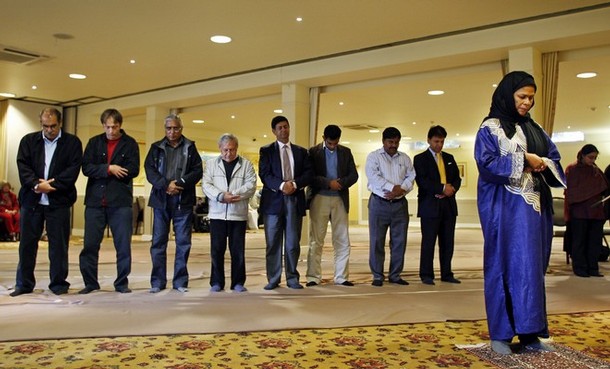Since my conversion to Islam, I have struggled with depictions of Muslim brides and wives in the mainstream Western media. From the images of famous non-Muslim women marrying famous Muslim men to the images of “pious” Chechen women sacrificing themselves for Syrian rebels, portrayals of Muslim brides and wives in mainstream Western media sources often depict two types of stories: either melodramatic romance novels or horror tales.
I was often left to wonder, is that all there is for Muslim women? While good and bad marriages happen in every culture, country and religious community, it was difficult to get even a glimpse of any healthy and successful Muslim relationships from mainstream media stories.
In recent months many stories about “Muslim marriage” have made it to news. Not only the rumours about Perry Edwards marrying Zayn Malik in a so-called “Muslim wedding,” but also the news on glamour model Carley Watts, who has said she will be converting to Islam and turning to hijab to please her Tunisian soon-to-be husband.
As in this case, romance stories involving converts and non-Muslim women often focus on the “pleasing the husband” aspect. Few converts or non-Muslims are ever depicted as assertive, independent women who make decisions by themselves (other than the decision to get married).
Stories of innocent or deluded brides often turn into horror stories post-marriage as marriages between converts and Muslims or Muslims and non-Muslims are treated with general suspicion.
When Muslim marriages are covered, it is often through the lens of common themes, i.e. child marriage, forced marriage, abuse, polygamy and feminicide. It might be inevitable that whereas happy and unproblematic marriages rarely make it to the media, sensationalist stories are almost guaranteed to headline, but coverage of Muslim marriages disproportionately represents problematic stories.
This is not to say that these stories do not deserve coverage, because they do. Discussing these themes is definitely important and necessary not only in the case of Muslims but any other group as well.
For example, in the past few days, a minor from Kerala was reportedly forced to marry a man from the Arab Gulf (some sources cite a man from the Emirates, while others describe a Saudi man). The man abused her and later abandoned her, causing uproar among human rights activists and Kerala authorities.
On a similar note, Qanta Ahmed wrote an article describing the murder of Farzana Bibi as the type of abuse that gives Muslims a bloodthirsty reputation elsewhere. The story which has been sparingly covered by mainstream media outlets was quickly picked up by anti-Muslim sites. Comparable stories though are often published by mainstream media and hate-speech outlets and are used to demonstrate Muslim men’s brutality.
As a convert, these media depictions posed a problem for me. They puzzled and worried me, and they meant that upon my conversion my family pictured me in black, heavy robes following a bearded man to the middle of the desert. The man would be an abusive husband that will not only lock me up but also physically and verbally abuse me. My family would shake papers at me and show me how bad Muslim men turn upon marriage based on the stories that my local newspaper published.
Aside from domestic violence and feminicide, mainstream media outlets have often focused on polygamy and the women that practice it, although no one presents reliable statistics. With UK having a large number of professional women practicing polygamy, some writers have characterized this trend as “Muslim libertarianism”- and I can only roll my eyes at this. The practice which is polemical among Muslims and often frowned upon in Western and non-Muslim settings, depicts Western-born career women “settling” for a second, third or fourth wife status for their own benefit. But while some remain skeptical of polygamy and the claims on increasing numbers of women practicing it, others see it as a form of marriage that can solve Russia’s economic problems.
When it came to polygamy my non-Muslim family would imagine a bearded Muslim guy showing up for dinner along with four wives and multiple children, as some media reports made it sound as if many Muslim men forced their wives into polygamy. Just the thought of it made my mother cringe.
Depictions of Muslim men as they relate to issues of abuse, polygamy, child marriage and other issues perpetuate the idea that these cases are unique of the Muslim community, and that women who marry Muslim men are inevitably doomed. However, as my Latin American experience attests, macho behaviour is common across many patriarchal cultures…including those that claim to save women elsewhere from their men (Bush, anyone?). And as sad and horrific as some of the “Muslim marriage” stories are (and this should never be forgotten), it is also important to remember that stories such as these are not inherently tied to any one group, culture or religion.
Portrayals of Muslim brides and wives are so limited it often seems from the outside that they are on an inevitable trajectory from fairytale exotic brides to suffering in horrific and abusive marriages. This drives me to ask how exactly normal portrayals of Muslim brides and wives can interject and disrupt this media-created storyline?
Eren Arruna Cervantes is a university student who focuses her research on politics of gender and women in organized religions. She aspires to engage in Shariah studies and to work with women’s organizations. You can read about her adventures as a new Muslim at her blog.
This post was originally published on Muslimah Media Watch.
Photo credit: Sephi Bergerson




